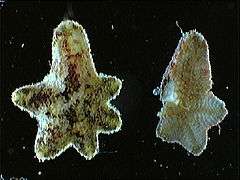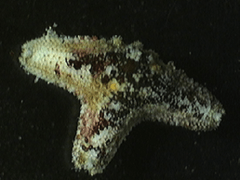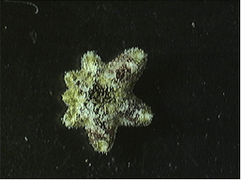Aquilonastra conandae
| Aquilonastra conandae | |
|---|---|
 | |
| Scientific classification | |
| Kingdom: | Animalia |
| Phylum: | Echinodermata |
| Class: | Asteroidea |
| Order: | Valvatida |
| Family: | Asterinidae |
| Genus: | Aquilonastra |
| Species: | A. conandae |
| Binomial name | |
| Aquilonastra conandae O'Loughlin & Rowe, 2006 | |
Aquilonastra conandae is a species of starfish from the Asterinidae family found near the Mascarene Islands in the Indian Ocean. It is known for its asexual reproduction and is fissiparous. It is a small starfish, discrete and camouflaged, and occurs in coral reefs in the surf zone of large waves. The species was described in 2006 by Australian marine biologists P. Mark O'Loughlin and Francis Winston Edric Rowe, and gets its name from Chantal Conand.
Description
It is a very small starfish (less than 2 cm (0.79 in)), with 7 to 8 short, rounded arms, often irregular in length. This is due to its potential of regeneration, but also to its ability to reproduce through fissiparity.[1] The arms measure 5 mm (0.20 in) in length, and the starfish has multiple madreporites and a single spine on the interradial plates. Solitary papules are present on the top of the starfish. Spikes are present and are rough, granular and crystalline, and are conical and prominent on the arms.[2] It has an irregular pattern of colours, showing a grey-beige background with granular patterns of reddish or greenish.[2]
 Aboral and oral faces.
Aboral and oral faces. A recently divided specimen.
A recently divided specimen. Regenerating specimen (probably after division).
Regenerating specimen (probably after division). Regenerated specimen, with an irregular shape.
Regenerated specimen, with an irregular shape.
Ecology and behaviour
Aquilonastra conandae reproduces by fission, in addition to sexual reproduction, which takes place at the beginning of the summer. The gonopores (genital openings) are located on the upper side, and the observed sex ratio is 52 males per 93 females, but some specimens are hermaphrodites.[1]
Distribution
This species was first spotted at Réunion Island (south-tropical Indian Ocean) at the breakers on a coral reef at a section known as the "Watering Hole" (south of La Saline les Bains), where it is abundant. It was later identified in all the Mascarenes (mainly Mauritius and Rodrigues), where it occurs between the surface and 10 m (33 ft) but more often on the reef front and rocky cliffs, but also on volcanic flows.[2]
Systematics
This species was described in 2006 by P. Mark O'Loughlin and Francis Winston Edric Rowe, on the basis of material collected by Chantal Conand at Réunion Island, who it was named after.[2] Its type specimen was collected in Trou d'Eau and is located in the National Museum of Natural History of France under the registration "IE-2013-2489".[3] The genus name Aquilonastra comes from Latin aquilonis (meaning northern), and astra (meaning star), referring to the fact that this genus of starfish is found in the northern part of the Indo-Pacific.[4]
A similar species, also fissiparous, was discovered on Europa Island in the Mozambique Channel, and was described in 2013 as Aquilonastra chantalae.[5]
References
- 1 2 Ooka, S.; Takeda, M.; Conand, C. (11 August 2006). "Sexual reproduction of the small fissiparous seastar Aquilonastra conandae (Asteroidea: Asterinidae) in La Réunion Island" dans Larry G. Harris, S. Anne Böttger, Charles W. Walker et Michael P. Lesser, Echinoderms: Durham : Proceedings of the 12th International Echinoderm Conference. Taylor & Francis. pp. 476–472. ISBN 978-0-415-40819-6.
- 1 2 3 4 O'Loughlin, P. Mark; Rowe, Francis W. E. (2006). "Echinodermata: Asteroidea". A systematic revision of the genus asterinid Aquilonastra O'Loughlin. 63. pp. 257–287. ISSN 1447-2554.
- ↑ "Aquilonastra conandae O'Loughlin & Rowe, 2006". MUSÉUM NATIONAL D'HISTOIRE NATURELLE. Retrieved 29 October 2014.
- ↑ "aquilonaris". Academic. Retrieved 29 October 2014.
- ↑ O'Loughlin, P. Mark; Mackenzie, Melanie (2013). Asterinid seastars from the Mozambique Channel (Echinodermata: Asteroidea: Asterinidae). 3613. Zootaxa. pp. 176–180. ISSN 1175-5334.
External links
- Aquilonastra conandae on World Register of Marine Species.
- Aquilonastra conandae on the Museum Victoria website.